The Murders on Lake Maggiore- Part 2 Baveno
The charming lakeside town of Baveno has seen its fair share of distinguished visitors ranging through John Ruskin, Queen Victoria, Crown Prince Frederick of Germany, Winston Churchill to Field Marshal Sir Jan Smuts. It also received a tragic and unwelcome visit from the Liebstandarte SS Adolf Hitler during World War Two. .
Baveno achieved a certain popularity with the British. Not least to the fact that Queen Victoria holidayed there. If Victoria put her metaphorical beach towels down first, the German were soon following. Queen Victoria’s , son-in law the Crown Prince of Germany came to Baveno to recuperate from the cancer that eventually killed him. Winston Churchill spent part of his honeymoon in Baveno before moving to Venice. In the 1930s, the nearby town of Stresa was more in the news as the sit of the 1935 Stresa Conference. During the war, the whole lakeshore was the site of mass murders, as more Germans this time the notorious Liebstandarte SS Adolf Hitler went on a cold-blooded killing spree in Baveno, Stresa and nearby Meina. Finally at the end of the war the distinguished South African Prime Minister, Field Marshal Sir Jan Smuts called in at Stresa and Baveno on his way home to south Africa from drafting the UN Charter in San Francisco.
If Crown Prince Frederick had ruled as Kaiser for more than 99 days, all the later tragedy might not have happened, and Winston Churchill might have returned from honeymoon to relative obscurity. Unfortunately that did not prove to be the case.
John Ruskin in Baveno
One of the first Britons to put Baveno on the map was the artist and art historian John Ruskin, He visited Lago Maggiore and the Borromean Gulf on at least four occasions before 1850. His first visit was in 1833 aged fourteen and enjoying his first continental tour with his parents. His second visit was in 1844. By which time he was something of a minor celebrity having published his first book, Modern Painters, volume 1, in 1843. Travelling again with his parents, Ruskin strained to be off amongst the peaks, whilst his parents preferred the more sedate climes of the lakeside resorts. He did enjoy Baveno, however, and his Diaries contain several references to the beauty of the lake, including a very specific record for 13 July of enjoying: ‘A lovely row in the afternoon to the opposite point [i.e. from Baveno to Pallanza], with the sun setting behind the Simplon and casting dusty beams along the hills of the shore.’ In 1845 Ruskin visited Baveno as part of a tour devoted mainly to the study of art and architecture in Italy, working towards the second volume of Modern Painters published in 1846. As a respite from the heat of high summer he spent two weeks at Baveno 18 – 31 August following a short walking tour in the mountains. On 24 August he was joined there by artist J. D. Harding ,The two spent a week sketching together – though the weather varied from unsettled to wet – and afterwards they travelled on to Verona and Venice.
His next visit to Baveno was in 1849. In that year he travelled in the Autumn to Venice with his new bride Effie and remained there throughout the winter. The railways had yet to reach that part of Italy, so Ruskin’s trips to Baveno involved a 12 hour crossing of the Simplon Pass by carriage from Brig in Switzerland to Domodossola, and then down the Ossola valley to Lake Maggiore.
The Railway Baron and his Villa
Another Briton, was instrumental in making travel to Italy much easier and also to boosting Baveno as a holiday destination for the British. Charles Henfrey was the son of an eminent British railway engineer and went into the family business. In 1843 he moved to Manchester and went into business with George Clark Pauling , founding the partnership Messrs Pauling and Henfrey which operated as constructors, contractors , brick manufacturers and wood merchants. During the golden years of the British railway development, Pauling & Henfrey did rather well winning contracts in 1844 for the Clifton and Bury and Bury and Rawtensall sections of the Manchester, Bury &Rossendale Railway. Although apparently, they were dismissed from the contract following some labour difficulties with workers being forced to break the sabbath. In any case, the partnership was responsible for a number of the brick tunnels , viaducts, and bridges in the Manchester area, Unfortunately, Pauling & Henfrey had a particularly bad reputation for its treatment of workers coming particularly to the notice of Fredrich Engels, who devoted considerable attention to them in ”The Condition of the Working Class in England” and other writings. In the view of Engels they were notorious for strikebreaking and using black leg labour. In January 1850, the partnership was dissolved and Pausing and Henfrey went their separate ways.
Charles and his brother George moved to Italy, where a new railway boom was starting. Together with the noted railway entrepreneur Thomas Brassey, they developed contacts with the anglophile Prime Minister of the Kingdom of Sardinia, Count Cavour. A newly formed company Jackson, Brassey and Henfrey won the contract to construct the Turin to Susa railway line. Presumably, the Italians ha not done much due diligence on Henfrey’s history of bad labour relations In the days before Italian Unification, the King of Sardinia , Vittorio Emanuele was also Duke of Savoy and was trying to link the Savoy part of his Kingdom with the part in Piemonte. Susa was a town in Italy below the Mont Cenis pass which connected Savoy and Piemonte. The Turin to Susa railway, linked the capital of Turin to Susa. It then continued on the Savoy side to the French border. The problem for the time being was Mont Cenis, which had to be crossed by road. The Turin to Susa line was opened in 1858, by King Vittorio Emanuele.
While in Turin, Henfrey got to know the lakeside town of Baveno and to but land there. While they were working on Turin to Susa, the Jackson, Brassey & Henfrey partnership contracted for an extension of the railway from Novara to Buffalora on the west bank of the Ticino. In 1859, the combined forces of France and Sardinia had defeated the Austrians at Magenta and Solferino, and the Armistice of Villafranca, had seen the Kingdom of Sardinia annex Lombardy, west of the Ticino, Jackson, Brassy, Henfrey also contracted for the line between Chivasso and Ivrea. In the end the railways Henfrey helped construct ran from Culoz, to Buffalora- with the exception of the Mont Cenis crossing. In fact the new British built railways facilitated the more rapid transfer of troops from Paris right to the border of the Austrian territory. As such it was said:
“ We may speculate also as to whether these railways would have been so opportunely completed without the aid of British enterprise, at a time when it was most required.; and perhaps be justified in concluding , that our countrymen may this have borne a humble part in bringing about the greatest result of modern civilisation- the unification of Italy. “
Having done his bit for Italian unification Henfrey went to India, where together with Brassy in a new partnership , he worked on the Delhi and Punjab railway. On 1st November 1868, Henfrey was at the top table at Umballa Railway station, when his Excellency the Viceroy, opened the branch from Umballa to Meerut. During the toasts , Colonel Drummond, paid particular tribute to Henfrey.
“And having frequent opportunities of inspecting the works in progress, I can testify to the admirably sound manner in which they have ben constructed by the contractors, Messrs, Brassey, Wythes and Henfrey. The presence in this country of one member of that eminent firm was alone assured guarantee of success.”
In replying to the toast, Henfrey extolled on the benefits the railway would have for the Punjab and in strengthening the British military hold on India. Perhaps showing that his attitude to workers had not greatly improved since Manchester, Henfrey opined. “
I am sure ladies and gentlemen that all here have had some experience of the native workmen and can well imagine the difficulties which beset the path of a contractor who undertakes the construction of a long line of railway. --- “
While he worked on his Indian projects , Henfrey continued to buy more land in Baveno. With his projects finished he returned to Italy , where back in partnership with brother George, he established the shipyard Giorgio Henfrey & Co, at Muggiano – then expanding through the Victoria Mining Company Limited into obtaining mining concessions in Liguria and Sardinia.
Although largely absent from Italy, Henfrey had employed a London architect Willian Allen Boulnois to build a Neo-Gothic mansion on the land he had acquired construction began in 1870/71, he named the villa after his second wife Clara., who he had married in India. Meanwhile, Henfrey became a collector of Italian Art, establishing a substantial collection. In the 1850s he started buy paintings from General Teodoro Lechi an Italian general, Jacobin and a military advisor to King Carlo Alberto of Sardinia.
Queen Victoria in Baveno
Henfrey’s magnificent villa and its art collection were becoming well known, he was approached by an aide-de-camp of Queen Victoria asking if she might rent the villa for a private holiday. Henfrey would not hear of accepting a rental and said the Queen could stay for free. In 1879, travelling under the identity of the Countess of Balmoral , Victoria took a private holiday at Villa Clara.
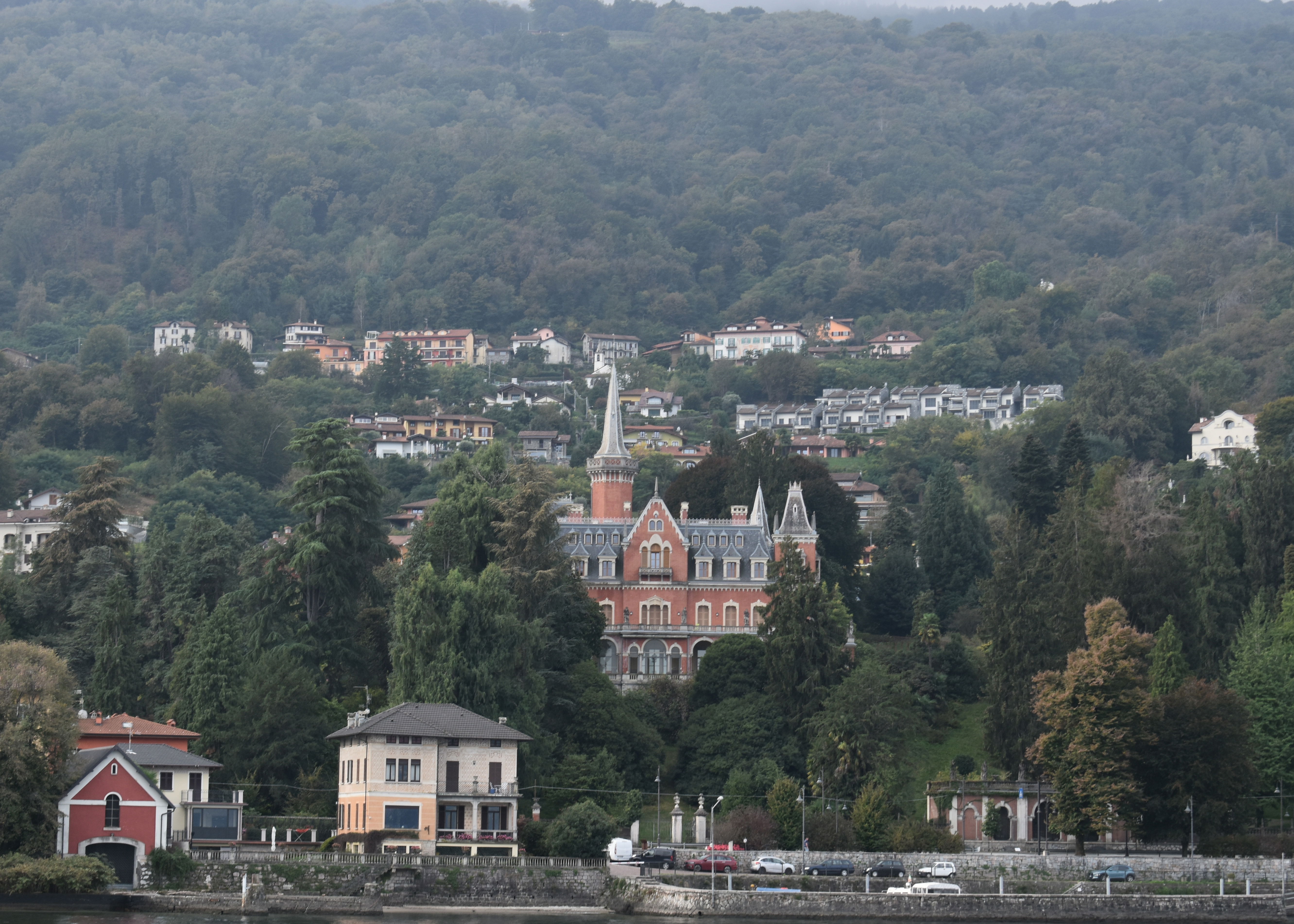
Villa Henfrey- Villa Clara at Baveno
By then Victoria had been widowed for 18 years, and in 1878 had lost her ”beloved child”, second daughter Alice. She travelled with her youngest daughter Beatrice, with her elder children all married, Queen Victoria relied on Princess Beatrice , who acted as her personal secretary , helped with correspondence, and sometimes took her mother’s journal entries. The Royal Party left Windsor on 25 March. the Queen and Princess Beatrice were accompanied also by John Brown, Victoria’s faithful servant and friend; Jane Spencer, Baroness Churchill , who from 1854 had been Victoria’s Lady of the Bedchamber and who regularly travelled with Queen. Also present on the tour were General Sir Henry Frederick Ponsonby , who since 1870 had been the Queens private Secretary and Keeper of the Privy Purse; Sir Willian Jenner- the Court Physician and Captain Fleetwood Isham Edwards, Assistant Private Secretary and Groom in Waiting.
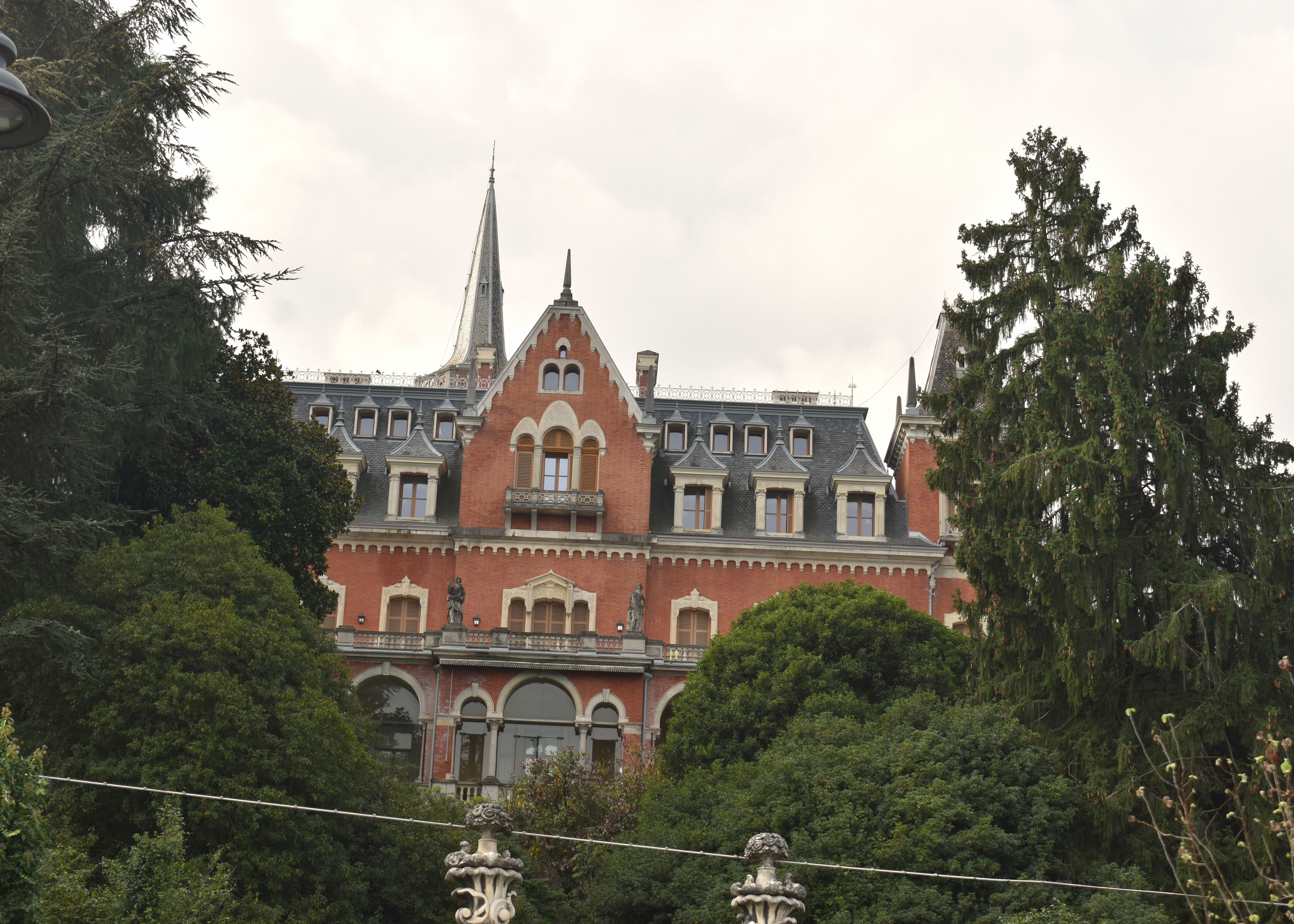
Another view of Villa Henfrey
The Royal Party set off from a snowbound Windsor, crossed the channel on the Royal Yacht to Cherbourg and then proceeded on the train via Paris to Italy. By the time , Queen Victoria travelled to Italy, things had moved on considerably from Ruskin’s day. In 1863, Count Cavour had done deal with the French to give up the Duchy of Savoy ad Nice, in return for French support against the Austrians. As anticipated Henfrey’ s railways had proved highly effective in moving French troops to Italy. Italy had become unified and King Umberto now ruled the whole Kingdom. The Mont Cenis tunnel ( also known as the Frejus tunnel ) had been completed and the Queen was able to travel from the French coast to Turin by train ( the last part from Susa to Turin on Henfrey’ s railway) and from Turin to Arona . The train still did not get as far as Baveno , but it was only a two or three hour carriage ride to Baveno along the lake shore from the railway station at Arona.. The press reported ;
Queen Victoria's temporary residence is Villa Clara, a beautiful house, or rather castle, built by one of our countrymen, Mr. Henfrey, and named after his wife. It is wholly constructed of red bricks and white Baveno stone ; the roof is of zinc and slate ; the floors fine Venetian scagliola work. The entrance is up two magnificent flights of steps, on each landing of which there is a bronze statue, both chef d'oeuvres. Arrived on the terrace there are outrances at each end of three loggie or galleries, all decorated with Gothic porticos in marble. From these through a lofty vestibule you pass into the interior of the castle, a grand staircase of Carrara marble at the end of the hall leading to the upper floors. The finest and most richly decorated rooms are on the first floor. Of these, there are each 30ft. square, and of incomparable elegance and fabulous richness. One ,is the banqueting-room, then comes the salon or drawing-room, and the third is the music-room. The walls are covered with white and gold brocade and the floors paved with mosaic ; the hangings are of richest Indian and Chinese stuffs, the furniture of extreme elegance and comfort ; there are Japanese vases and Sèvres porcelain, monster mirrors, pictures, curiosities, musical instruments ; everything, in fact, necessary for princely and refined leisure. On the second floor are the Queen's private apartments, and those of Princess Beatrice and the two ladies in waiting. The royal bedroom is hung with gray and gold brocade, and furnished with every luxury ; but one piece of furniture is in marked contrast with its surroundings, and that is her Majesty's travelling bed, which came with her from England, and is an object of extreme curiosity to the Italians, who are astonished at the idea of anyone not being contented and charmed with the enormous and cumbrous four-poster they consider the proper thing for the nightly repose of royalties and nobles, and which is always an important article in every house. It ís impossible to say whether Queen Victoria's bed is correctly described as to any-thing but its small size and simplicity, but it is stated to be of plain walnut wood.
The views from every window and terrace are of exquisite beauty, and I must not forgot to mention the little English Church in the villa grounds, which is a perfect gem. It is of octagon shape, in the Pisan style, all columns and charming archivolts. The outside is covered with bas reliefs and friezes, and volutes in Baveno stone ; the interior is all marble, gold, and mosaics, which imitate perfectly those of St. Mark's, at Venice. Our gracious Queen is reported to be entirely pleased and happy in this little earthly Paradise ; living a retired and simple country life, spending her mornings on the terraces, sketching in the shade, and driving and boating in the afternoons. She visited the Isola Bella, where she was amazed at the beauty of the gardens, in which grow all the trees and plants of the tropics in the open air ; famous for its laurels especially, and the tea plants and camphor trees. There has been a serenade for her Majesty on the lake, and magnificent bouquets of flowers have been presented her by the Milanese nobles. That sent by Count Borromeo measured one metre eighty centimetres in diameter, and was composed of countless camellias, heliotrope, and maidenhair fern. The Queen is said to be especially wonderstruck at the profusion of maidenhair everywhere, a tender hothouse fern in England. Soon after her arrival the Duke d'Aosta, King Humbert's brother, went to welcome her in the King's name ; and the King and Queen Margherita are going in a few days to pay her English Majesty a visit of compliment. They will reside for the time at Stresa, near Baveno, in the villa of the Duchess of Genoa, Queen Margherita's mother. Garibaldi has sent his message of welcome to Queen Victoria in the name of the Italians to whom England was such a steady friend during the whole period of the struggle for freedom and unity which was completed by the taking of the Eternal City on September 20, 1870.”
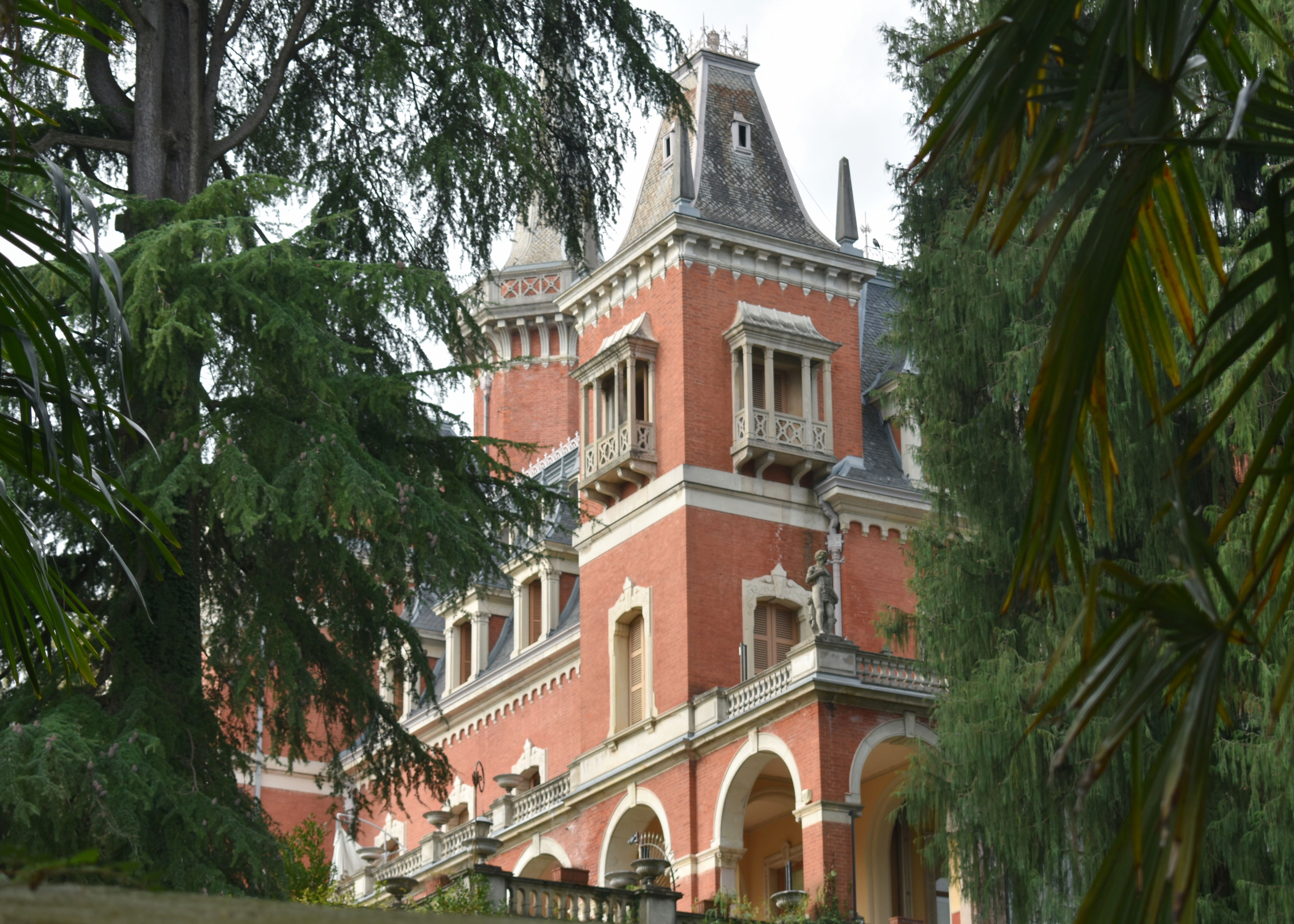
Villa Henfrey
Queen Victoria was not the only Royal visitor to the Villa Clara. Crown Prince Friedrich the only son of Emperor Wilhelm I (and Victoria’s son in law ) also stayed there while being treated for his eventually terminal cancer in October 1887 . Friedrich had bravely stood up to Judenhetze [agitation against Jews] and the attempt at dis emancipation of Jews in 1880s Germany. Clad in the uniform of a Prussian field marshal, Friedrich, together with Victoria, attended a synagogue service in Berlin in 1880 to show support for tolerance. Friedrich's mother-in-law, Queen Victoria, wrote to thank him for his speech, saying she was proud that her daughter had married someone like him, but within Junker circles, Frederick was widely criticised for his actions in support of the Jews. Prominent among the Crown Prince's critics was his eldest son, Wilhelm, who called his father a weak, cowardly man controlled by his British wife and the Jews. Unfortunately Friedrich had been suffering from laryngeal cancer for some years and was sent to Italy for a change of climate.
On 6 October, Friedrich, his family and a British doctor who was caring for him Morell Mackenzie arrived at the villa Clara, with Mackenzie leaving Baveno on 8 October. Their elder son Wilhelm joined them at Baveno on 17 October for Friedrich’s 56th birthday the following day. At the end of October, his condition abruptly worsened, Wilhelm reported to Albert, King of Saxony that his father was frequently short-tempered and melancholic, though his voice appeared to have slightly improved, and that his throat was being treated by "blowing in a powder twice a day to soothe the larynx. On 3 November, Friedrich and his entourage departed for San Remo to the Villa Zirio, at. During the winter of 1887-8, all the world was watching the race between the two lives—that of the ninety-year-old Emperor, and that of his son, already stricken with a mortal disease.
Friedrich had a long history of liberalism admiring Prince Albert and the British parliamentary system, he and his wife planned to rule as co-monarchs and liberalize Germany through the appointment of more liberal ministers and limiting the office of Chancellor. Some historians consider tat Frederick's early death put an end to the development of liberalism within the German Empire. speculating that , given a longer reign and better health, Frederick might indeed have transformed Germany into a more liberal democratic country, and prevented its militaristic path toward war. It is of course hypothetical but claims that Frederick would have averted World War I, the rise of Adolf Hitler and by extension the outbreak of World War II. Unfortunately it is just speculation It did not happen as the inhabitants of Baveno would unfortunately find out 60 years later.
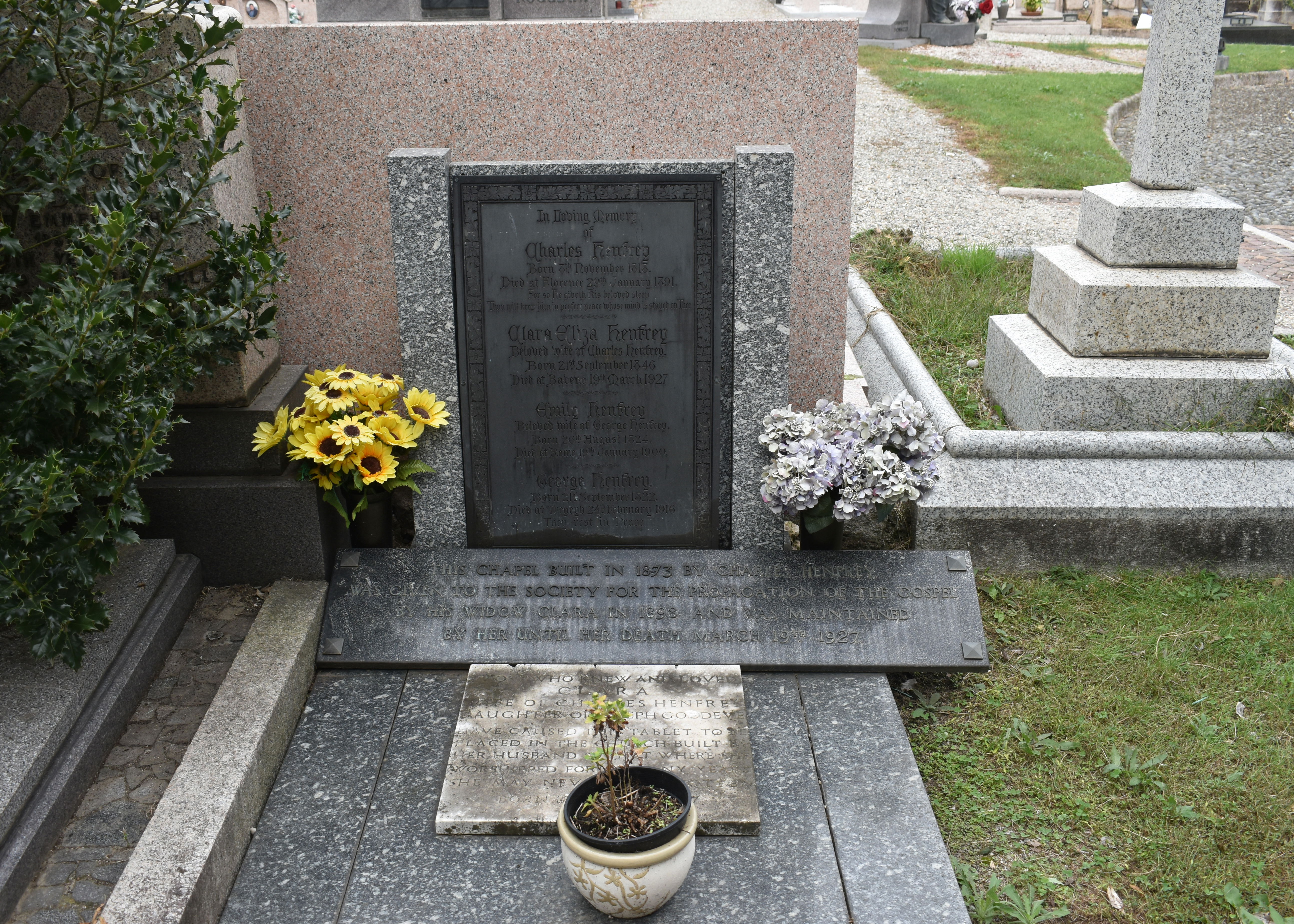
The Henfrey family graves in Baveno
Churchill’s Honeymoon
Winston Churchill , then recently appointed President of the Board of Trade , married Clementine Hozier on 12 September 1908 at St Margaret’s , Westminster, After spending the first few days of their honeymoon at Blenheim Palace , the travelled to Italy, where they stayed at the Hotel Lido Place in Baveno , before going on to Venice and then to Castle in Moravia. Back in 1908, Churchill was still a Liberal MP Asquith succeeded the terminally ill Campbell-Bannerman on 8 April 1908 and, four days later, Churchill was appointed President of the Board of Trade, succeeding Lloyd George who became Chancellor of the Exchequer. Aged 33, Churchill was the youngest Cabinet member since 1866. Newly appointed Cabinet ministers were legally obliged to seek re-election at a by-election and on 24 April, Churchill lost the Manchester North West by-election to the Conservative candidate by 429 votes. On 9 May, the Liberals stood him in the safe seat of Dundee, where he won comfortably.
The Murders on the Lake
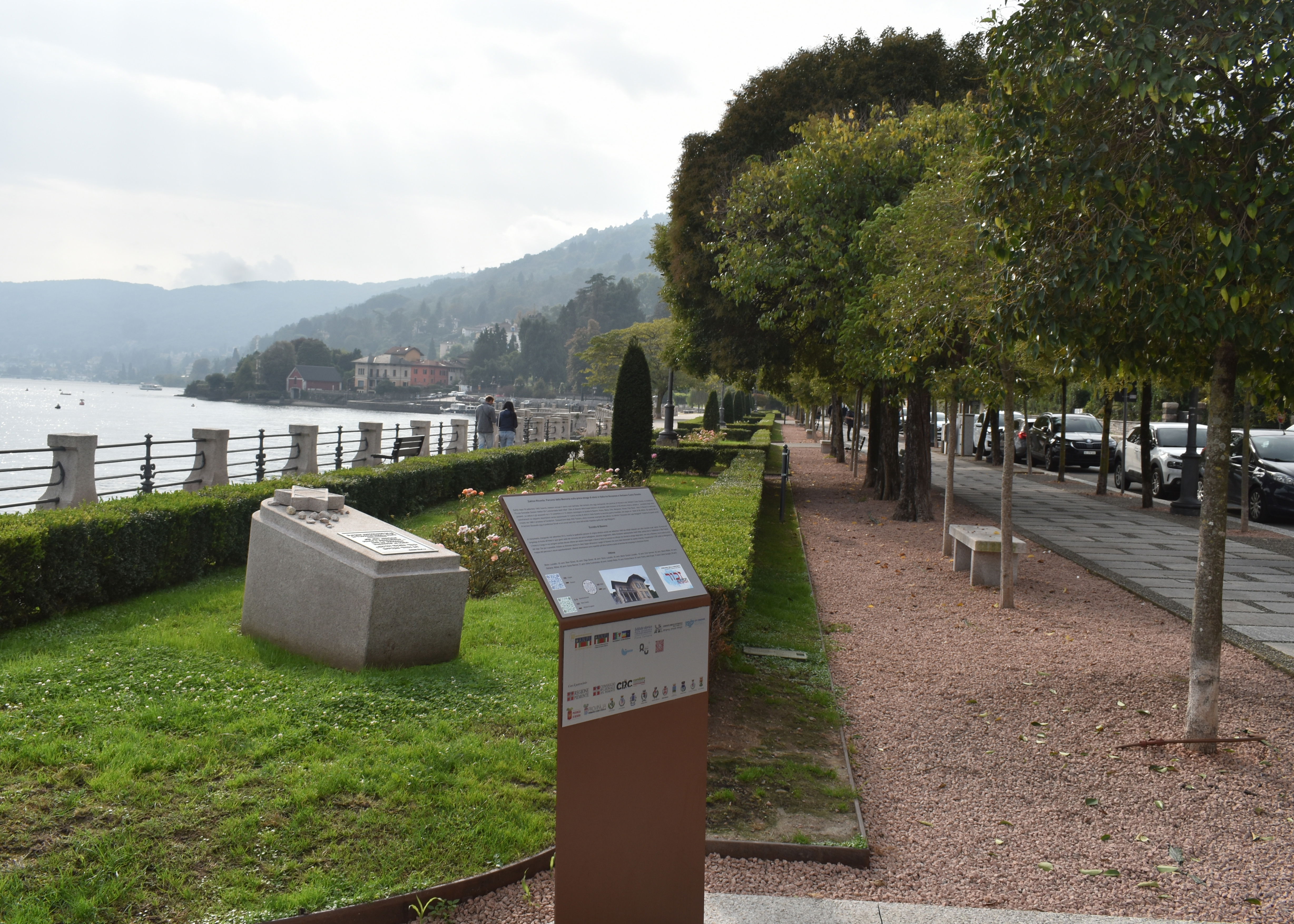
Memorial to the Shoah on the lakeside at Baveno
As at Meina the war destroyed the tranquillity with a wartime massacre. Again the murderers at Baveno were men of the Liebstandarte SS Adolf Hitler ( LSSAH) who arrived around 13 and 14 September , a battalion under the command of Hauptsurmfuehrer Friedrich Hans Röhwer installed themselves at the Hotel Beau Rivage (later moving to the villa Fedora). The 4th company under Obersturmführer Friedrich Bremer occupied the Hotel Belle Vue before moving to the Beau Rivage and the 5th company under Obersturmführer Karl Schnelle billeted at the Hotel La Ripa Other companies billeted at Stresa, 5th company under Obersturmführer Hans Krüger the 1st Company under Obersturmführer Max Sterl at Pallanza and the 2nd Company under Hauptsurmfuehrer Gottfried Meir at Intra. Röhwer, Schnelle and Kruger a former locksmith , unsuccessful civil service applicant and a painter now effectively had powers of life and death over Baveno. (The ordinariness and lack of success in their early lives is well documented in the court filings at their subsequent trial, so seems little point in detailing further in this account).
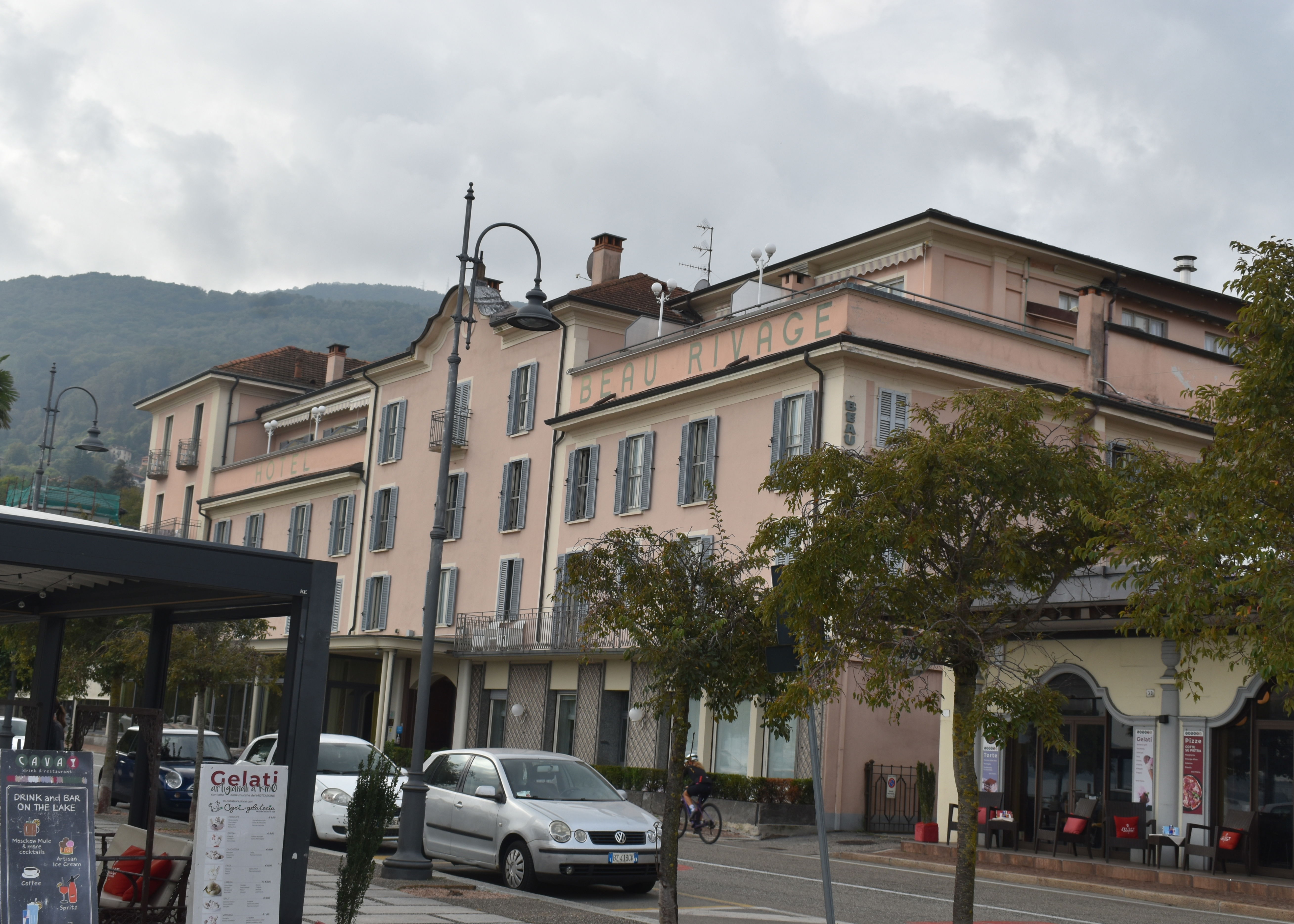
Hotel Beau Rivage - occupied by the German command during the Nazi occupation
Before its arrival in Italy, the LSSAH had been responsible for a string of atrocities including the murder of 81 surrendered and disarmed soldiers from the 2nd Battalion, Royal Warwickshire Regiment, 4th Battalion Cheshire Regiment, 210 Battery, 53rd (The Worcestershire Yeomanry) Anti-Tank Regiment, Royal Artillery and French soldiers at La Plaine au Bois near Wormhout. Those responsible for the massacres on Lake Maggiore seemed to have arrived after this event , but it speaks to the overall poor reputation of the formation.
As soon as they arrived in Baveno, the LSSAH began searching for the Jewish inhabitants. Unfortunately Italian record keeping of the population was quite efficient in recording religions and addresses. The Italians had not thought to destroy these useful lists before they fell into German hands .

Baveno town hall
Among the first to be detained in Baveno was Mario Luzzatto. Having graduated in 1912 Mario Luzzatto started a promising career which led to him becoming a senior executive with Pirelli in Milan: after nine years in the administration of the company from 1919 to 1935 he became Procuratore generale and director of tyre sales in Italy and overseas. In 1935 he was nominated vice direttore generale and given the responsibility for "Pirelli-Rovere, Società italo-americana Filo Elastico", a new company specialising in elastic textiles. He also held a number of external roles for ten years from 1918 to 1929, he was the secretary of the Associazione italiana tra gli industriali della gomma, dei conduttori elettrici ed affini. He also was a member of the executive committee of the Salone dell'Automobile on the invitation of the Associazione Nazionale Fascista Industriali dell'Automobile. He enrolled in the Fascist Party( PNF) on 29 December 1932. Mario Luzzatto was also Jewish.
After the entry into force of the racial laws on 2 December 1938 Mario Luzzatto presented a demand for exemption known as “discriminazione”, which allowed some jews , at the discretion of the Ministry of the interior to be exempt from some of the persecuting laws. While the demand was being processed , Pirelli transferred , Luzzatto and his family to England as director of the British subsidiary of Pirelli at Burton-on Trent, Staffordshire . In Burton he was a prestigious local figure , appearing in local newspapers on Pirelli sports days and handing out prizes. Unfortunately, it was not to last.
In fact it was not only Mario Luzzatto, that Pirelli seem to have assisted to escape the impact of the Racial Laws , another seven Jewish employees in Senior Executive positions, were assisted . Although “forced” to terminate employments, Pirelli, paid generous termination gratuities ( more than they were legally obliged to do ) and where possible managed to relocate the employees to safer overseas jurisdictions. So Michele Brodsky, and Maurizio Lustig, were placed with Pirelli Platense in Buenos Aires, Alessandro Diena, director of tyre exports went to Pirelli Gummiringe in Copenhagen; Ugo Tagliacozzo, a director of administration , opened up a consultancy in Sao Paulo in Brazil of which Pirelli Brasileira was the principal client.
On 10 June 1940, Italy declared war on Great Britain and France , almost straightaway the British rounded up Italians living in the country. Unfortunately, rather than being interned in the UK , Luzzatto asked to be repatriated to Italy. Together with diplomats from the Italian embassy and other officials and business people who had elected for repatriation, he was taken to Glasgow and put on the troopship the Monarch of Bermuda for transport to Italy. At the same time the Italians expelled
On his return to Italy Luzzatto tried to reactivate his request for discriminazione, which had lapsed while he was in the UK. In 1941 together with Federico Jarach he helped to set up courses in chemistry equivalent to university courses at the Jewish school in via Eupili in Milan, they called back Jewish professors who had been expelled from public schools following the racial laws including professor Ciro Ravenna from Ferrara for the chair in chemistry, Augusto Levi from Venezia to teach physics , Guido Ascoli, a mathematician from Turin of worldwide repute. The course which lasted for seven months provided Jewish students with significant opportunity for study. Ravenna was arrested on 15 December 1943, and deported to Auschwitz il 22 February 1944 (on the same train as Primo Levi), he was murdered on the day of his arrival in the camp on 26 February 1944. Augusto Levi was deported to Auschwitz on 31 July 1944 and was murdered. Guido Ascoli survived the Shoah.
In 1942, Luzzatto was forced to leave Pirelli as a result of the racial laws , again the company tried to do the right thing by finding him a new external role, researching the history of the company for is 70th anniversary in 1942. Luzzatto collected together original documents, transcribe records, and made photographic copies to help him with his work. Luzzatto’s work at least provided the survival of Pirelli’s archives, which were subsequently destroyed by British bombing of Pirelli’s plant and offices in Milan. As a result of the increasing number of British air raids on Milan , he moved his family to Baveno, where he owned a villa "Il Castagneto" which was used for family holidays. Luzzatto’s villa was hidden away on the via Marconi, away from the town centre and with a panoramic view overlooking the lake. He might well have expected to remain safe up there while the Germans occupied the centre of town and the lakeside area. He continued to work on the "Storia delle industrie Pirelli", unfortunately he managed to complete inly the period 1872-1920 before time ran out.
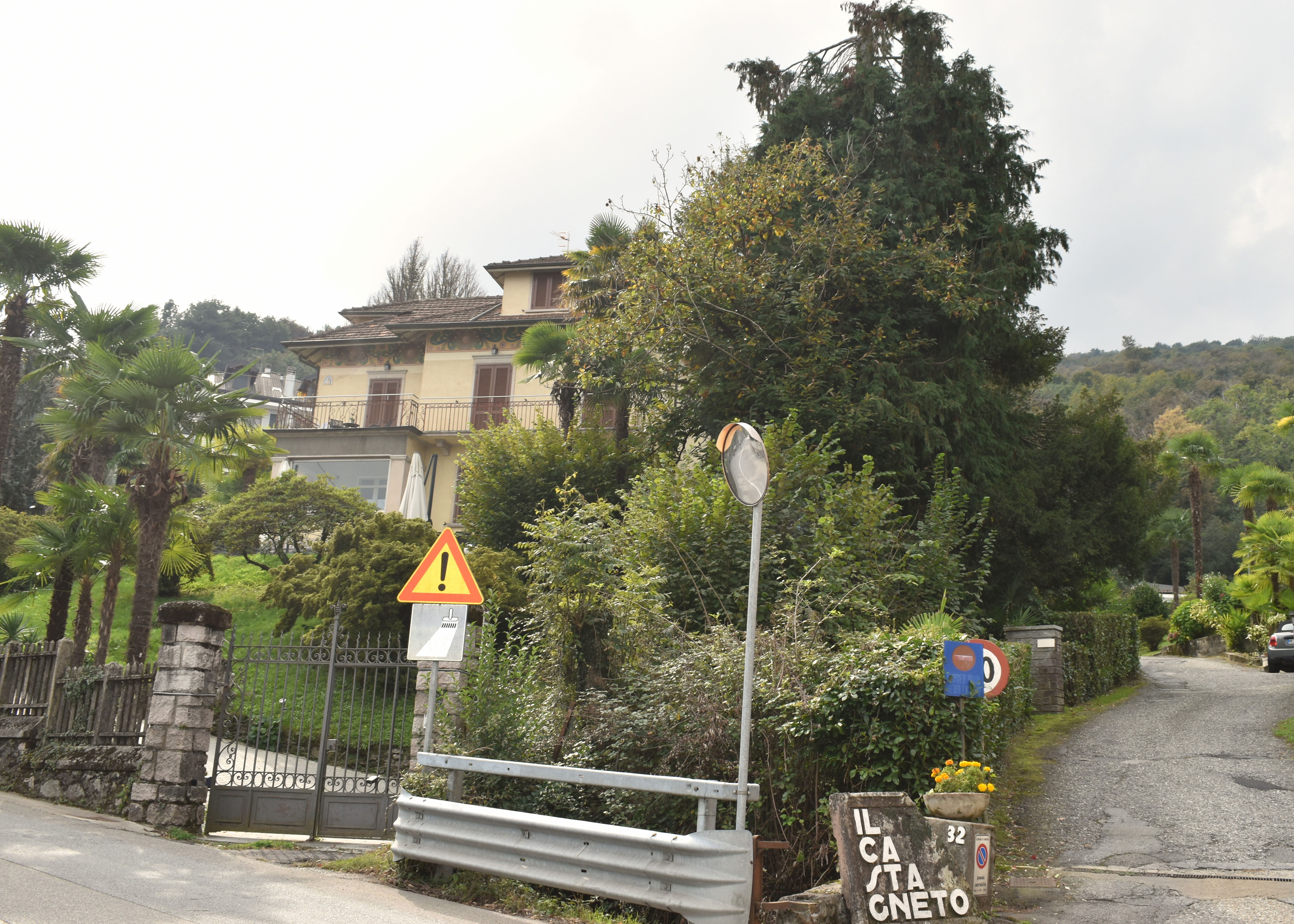
il Castanetto- the Luzzatto family villa in Baveno
After the LSSAH arrived at Baveno, family and friends tried to convince Mario Luzzatto to flee to nearby Switzerland. On 13 September 1943 he was arrested at the villa and transferred to the SS HQ at the Hotel La Ripa in Baveno, in the evening of 13 September, the rest of Mario’s family was taken by the SS , including his wife Bice Ginesi and her sister Olga who was staying with the family. Mario’s daughters Maria Grazia and Silvia were students at the Liceo Parini in Milan up to the end of the year 1937-38 (V Ginnasio), in 1938 they were expelled from the school following the racial laws They continued their studies at the Jewish school in via Eupili, Their exact fate of the family is unknown, probably they were murdered by men of the LSSAH on il 21 September, along with the other Jewish residents rounded up , killed on the beach near villa Ruscello, and their bodies disposed of in the Lake. The events at the villa were later recounted by a number of witnesses at the subsequent trial of Röhwer, Schnelle and Kruger in Osnabruck in 1968
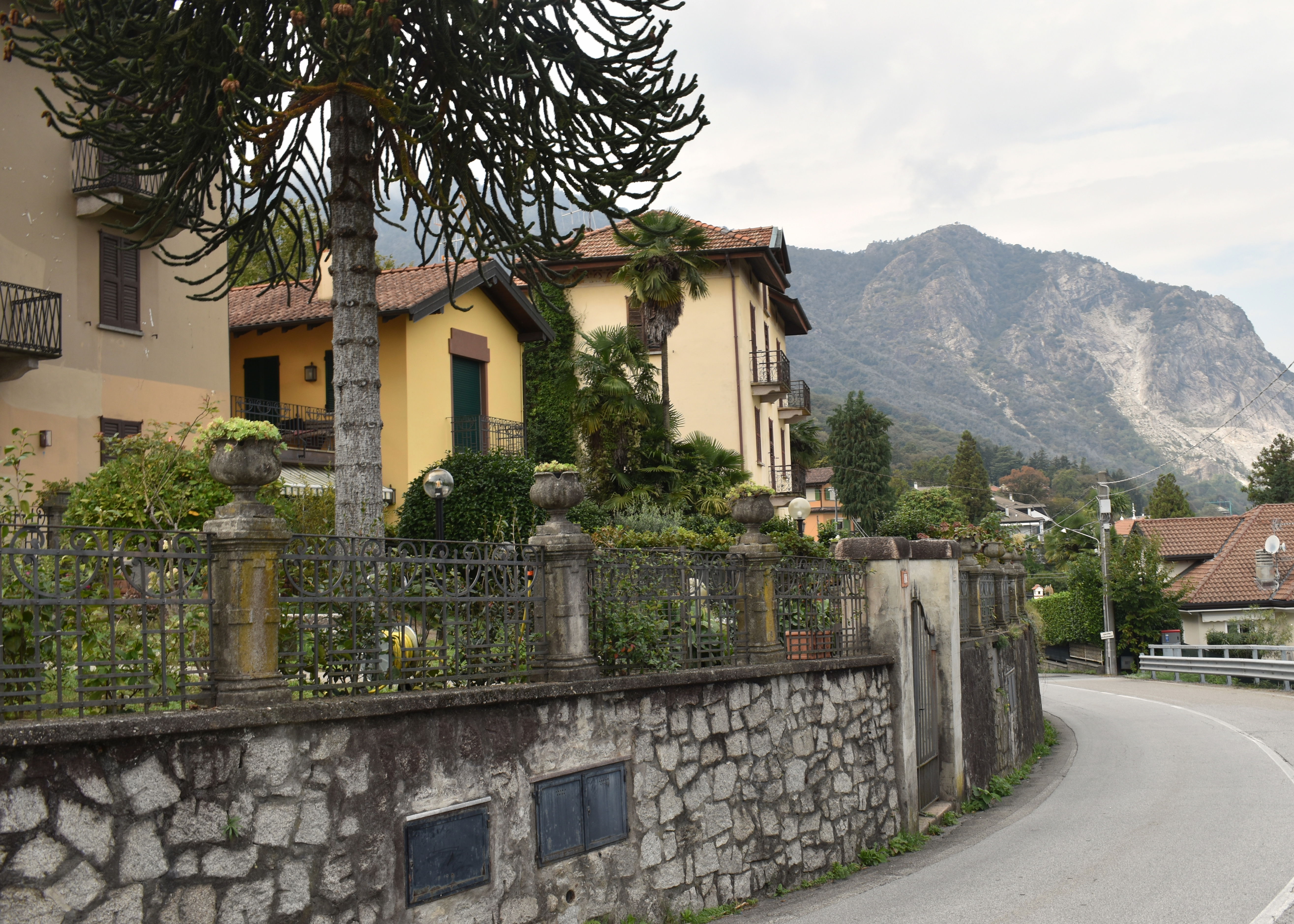
Via Due Riviere 80, the Wolfsi family villa in Baveno
A little further up the hill from the Luzzatto family, at via Due Riviere 80,lived Joseph Wofsi, an aging Rabbi originally from Daugavpils in Latvia with his wife Emma Baron. They had come to Italy for work in 1924 , moving to Milan where Joseph worked as a merchant. They both obtained Italian citizenship and in 1938 moved to Baveno where they rented the house at via Due Riviere 80. After the Racial Laws their citizenship was revoked and they became stateless. Nevertheless they managed to avoid expulsion from Italy on account of their advanced age , but were still interned and sent to Ospedaletto d'Alpinolo, in Avellino, In 1941 they were allowed to return to Milano, and subsequently after ( September 1943 to Baveno, where they had continued to rent the house. Once the SS had picked up the Luzzatto family, they turned their attention to the nearby Wofsi family. Both Joseph Wofsi and Emma Baron were murdered sometime between the 15 and 22 September 1943.
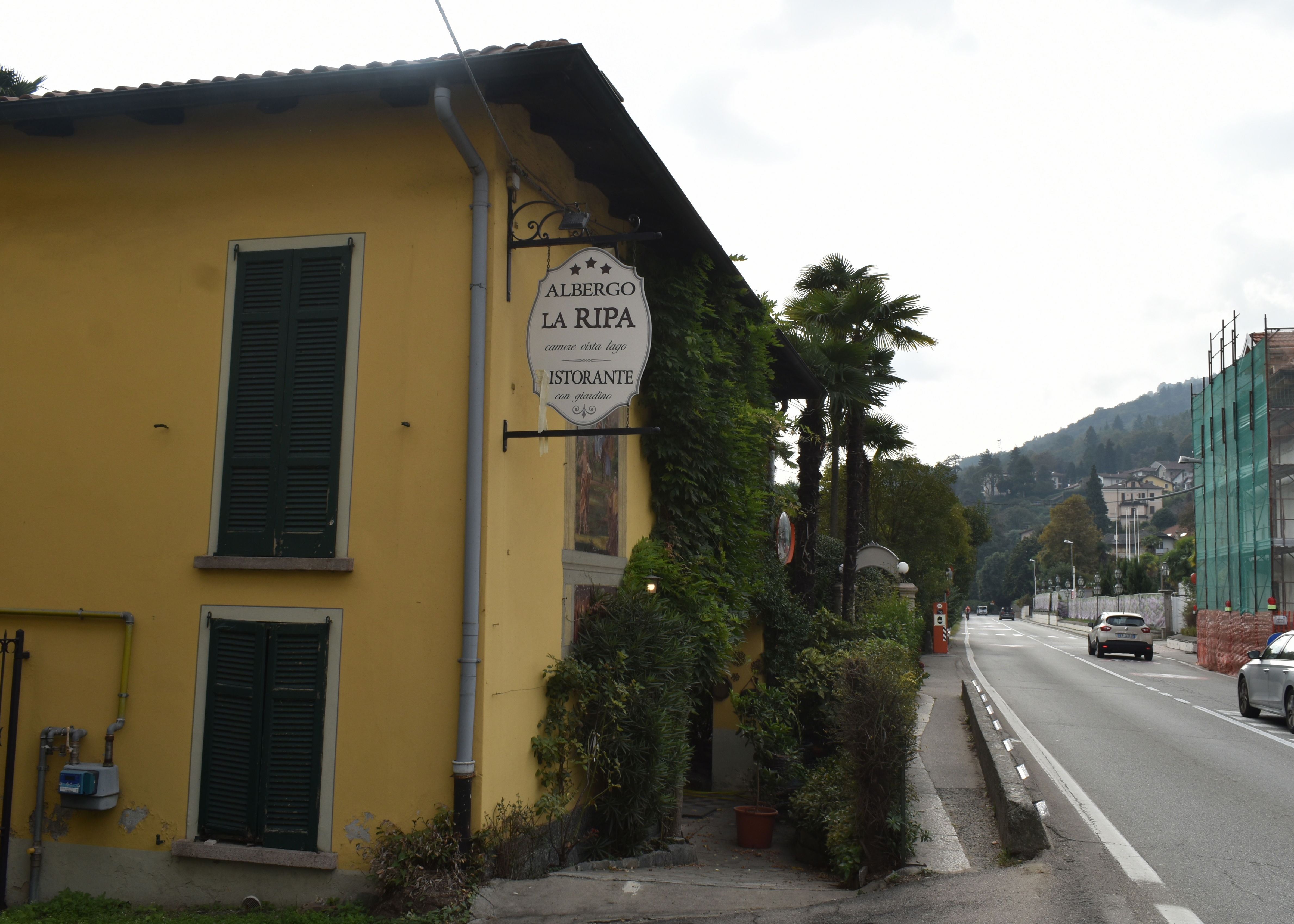
The Hotel la Ripa- also occupied by the Germans during the war
On 14 or 15 September Obersturmführer Karl Schnelle went to the podestà Columella to find the location of villa Fedora, where the Serman family were living . Villa Fedora was on the other side of town from Luzzatto’s house. It was a villa set in park land with a view over the lake. Constructed in 1861, the villa was described as a building of "simple modest architecture, pleasant for the elegance of style and beautiful harmony, enlivened by a beautiful and vast garden. The villa is equipped with dining rooms, reception lounges, with adjoining stables. The garden, already well structured, has botanical varieties and a forest with tall trees.” The composer Umberto Giordano, lived in the villa from 1904 to 1924, he named it after his favourite work "Fedora", an opera actually composed when he lived at Pallanza across the lake . He had composed his last works in a hut, he had built in the villa grounds.
In 1924 Giordano and his family moved to Milan, then Sir Edmund Gabriel Davis, an English entrepreneur of Jewish origin, took over the villa. Born in Australia in 1861, into a mercantile family, Davis was brought up in Paris from the age of eight, and studied art. In 1879 he left for the Cape Colony launching him on the path to power and fortune in the South African mining industry. During the First World War he worked closely with the British Admiralty and Ministry of Munitions and was instrumental in securing supplies of vital minerals for Britain and France. A passionate collector of art, in 1915 he presented a selection of modem British works to the Luxembourg Museum, Paris. After the war he played a key part in the development of the copper fields of Northern Rhodesia and joined the Board of the British South Africa Company; Most of his collection of works by Old Masters resided at his home, Chilham Castle, near Canterbury. Davis died in 1939, and the Villa fedora was rented out.
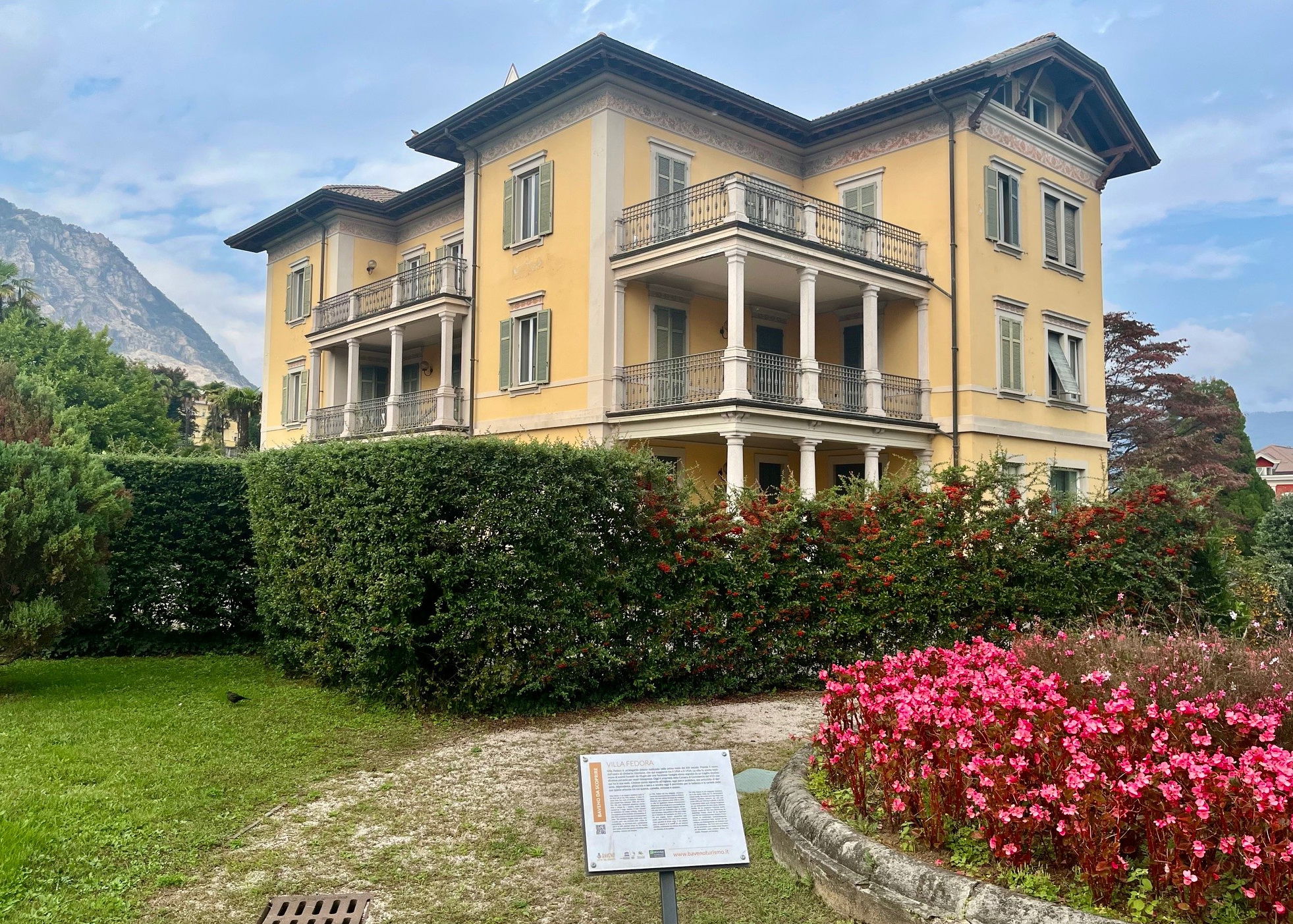
Emil Serman was born in Vienna on 29 April 1881 , after a youthful experience as a journalist on a Berlin daily newspaper, he became an entrepreneur in the paper import business . In 1924 in Berlin he married Maria Müller, a Polish Jew. As the situation in Germany deteriorated the couple emigrated to Italy, together , Maria’s sister Stefania and mother, Giulia Werner . both also Polish .citizens. They originally settled in Milan, then following Italy’s declaration of war on Britain and France in 1940, and first British bombing of Milan they moved to Baveno where Serman rented the Villa fedora . Also staying at the villa was Sofia Czolosinska a friend of the family. Although Italy’s Racial Laws had provided for the expulsion of foreign-born Jews, the Sermans remained unmolested until the LSSAH arrived in Baveno. Emil Serman had just come back from Stresa where he had been playing tennis, unfortunately he had apparently did not heed warnings that the Germans had arrived and were surrounding his house . When he arrived Obersturmführer Schnelle initially treated him cordially, while negotiating for some of his men to be billeted in the house. Then his attitude changed, and he ordered Serman to follow him to the Albergo La Ripa., witnesses apparently saw him handcuffed and imprisoned there. In the afternoon the SS returned to villa Fedora and removed Maria Muller. Stefania Müller, Guilia Werner and Sofia Czolosinska. Also detained the same day was Carla Caroglio, a 25-year-old woman who was holidaying in Baveno. She was detained for apparently being out in the company of two Italian convalescent soldiers and possibly giving the Germans a bad look. Schnelle accused her of being Jewish and had her arrested anyway.
All of the prisoners were murdered probably on the lakeside, somewhere between 15 and 22 September, with their bodies most probably being dumped in the lake.
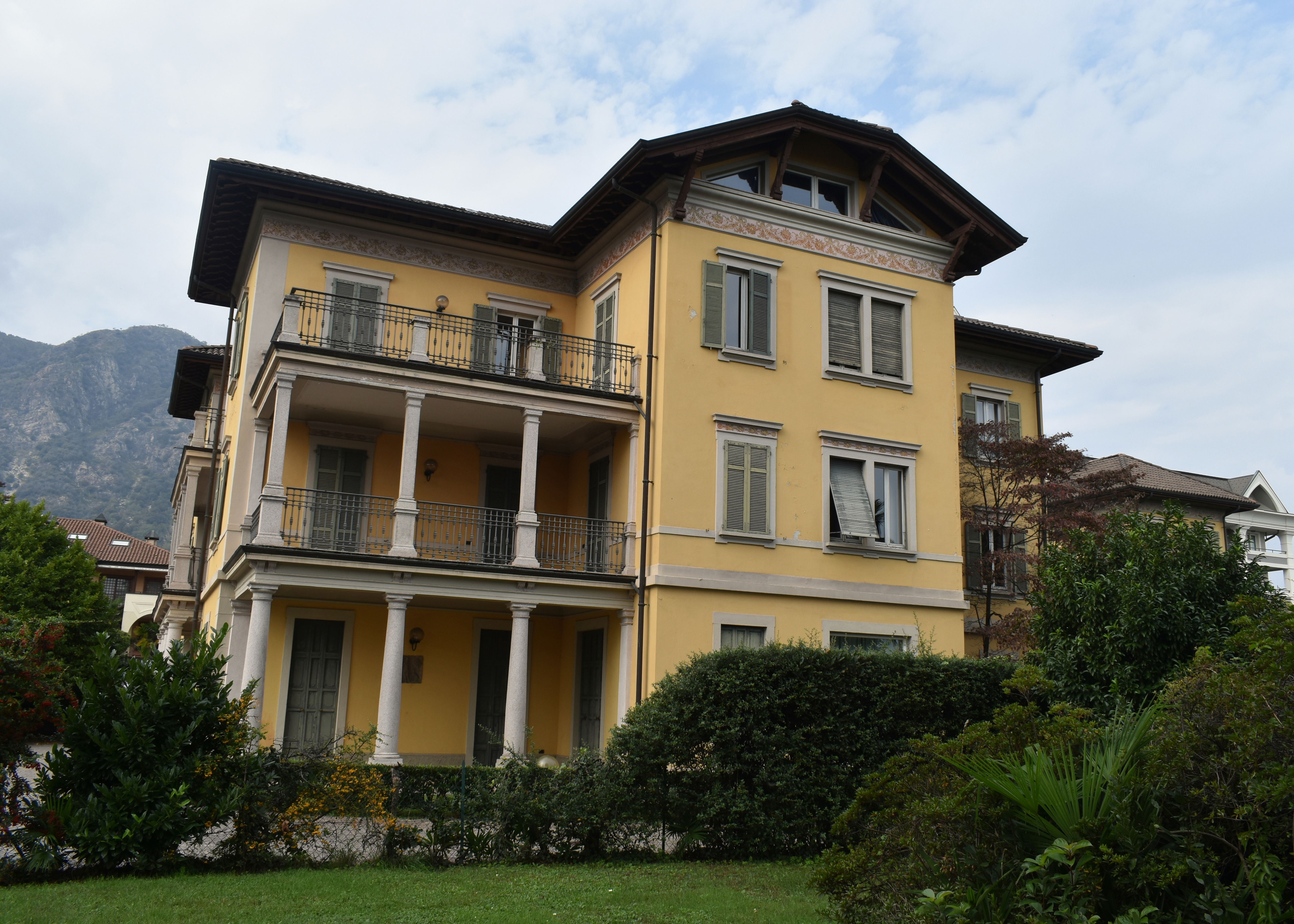
Villa Fedora - Baveno- last home of the Serman family
More fortunate was Luzzatto’s friend Federico Jarach with whom he had helped set up the clandestine university. Jarach was also on Lake Maggiore at his villa outside Arona when he received a call that the SS were on the way to pick up his family Jarach did not hesitate to load his large family into a boat and rowed across the lake to Ranco, on the opposite Lombardy shore of the lake. He was still in Italy but for the moment safe from the murderous rampage of the LSSAH on the Piedmont shore. With the help of Luciano Visconti , his custodian he managed to hide host family at Dumenza in the hills above the lake. Jarach then travelled to Rome, where he lived under a false name until the Allies liberated the city on 5 June 1944. His entire family survived.
Fortunately for the local population "Liebstandarte SS Adolf Hitler" left the area in October, a German presence remained with the Feldgendarmarie, comprising mainly Austrians and East Europeans, with German officers commanded by capitano August Burmeister . From early 1944.with the intensification of partisan activities , SS Polizei(regiments 15 and 20) who were based at the villa Carbora in Intra, and under the control of SS HQ in Monza also arrived. Unfortunately Baveno’s bloody wartime history did not end in September 1943. On the evening of 20 June 1944 the partisan group "Falchi del Mottarone", led by Franco Abrami came down from the mountains to Baveno and carried out a daring coup in captured two Germans and three local Fascists who they intended to exchange for captured partisans- While this was happening , Franco Abrami and other partisans ambushed a car coming from Feriolo and in a firefight killed Hauptmann August Burmeister and a major in the GNR ( the Fascist Militia)Francesco Scotti. Word on the street was that the two were responsible for a previous massacre of partisans at Fondotoce. Unfortunately , while returning to Mottarone, Franco Abrami was killed by one of the prisoners who had managed to conceal a pistol . In revenge the Germans murdered 17 captured partisans in the piazza dell'Imbarcadero on the lake front at Baveno on 21 June 1944 , mainly they had been captured in Val Grande and Val Cannobina and held in prison at nearby Intra. The bodies of the murdered partisans were left exposed on the lakefront before being buried in a communal grave at the cemetery in Baveno.
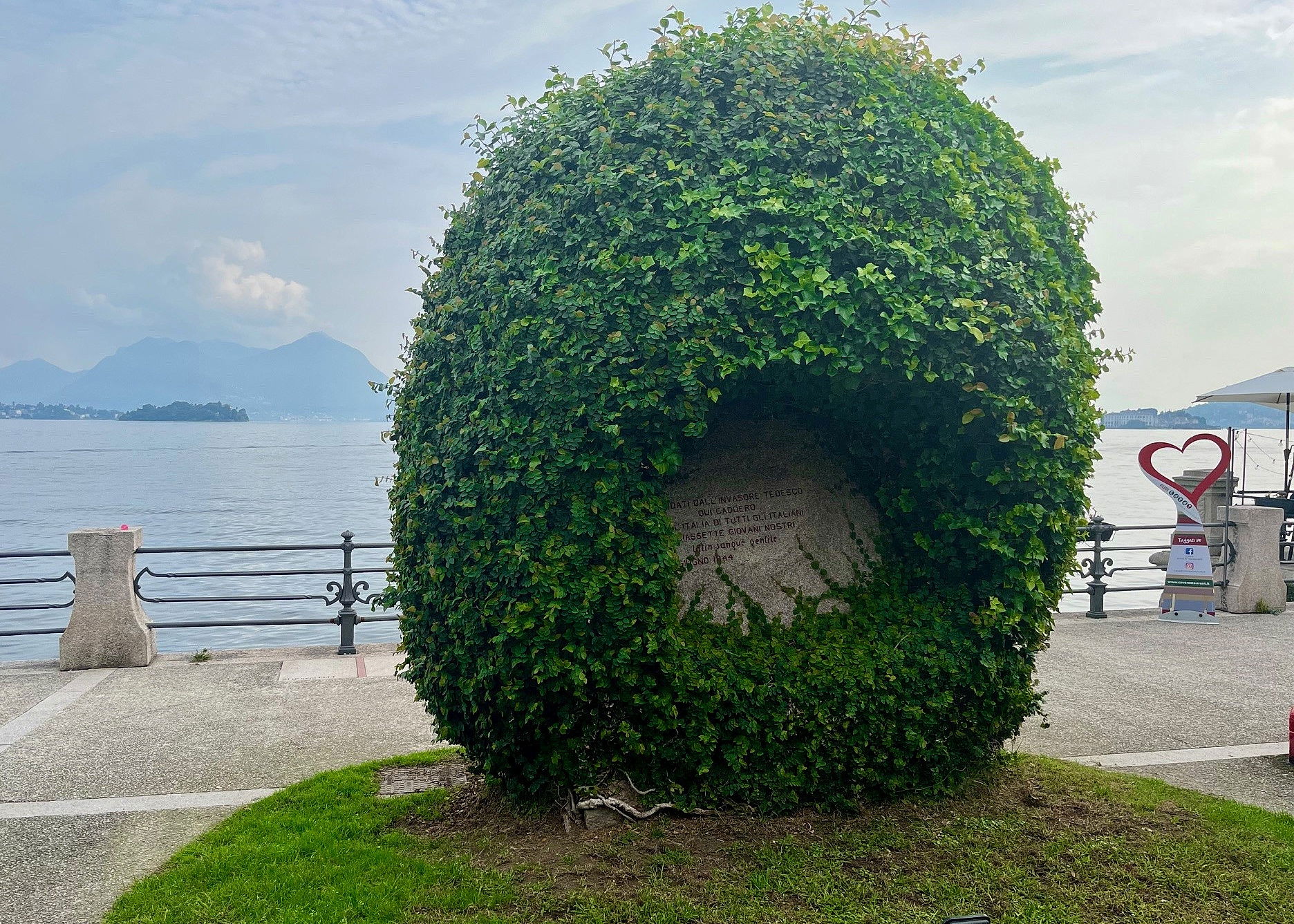
At the end of the war, the Germans departed and Baveno was temporarily occupied by the HQ of the 6th South African Armoured Division. These hardened men from the veld had fought their way up from the heel of Italy ,through Monte Cassino, Siena, Lucca and the Po Valley. After the liberation of Milan, the 6th Armoured Division, by then part of US Fifth Army was dispersed throughout North- western Italy in Turin, Liguria and Aosta. Aosta was tough assignment, as the vengeful French sought to encroach across the pre-war Italian border. The South Africans suffered around 1,100 killed in the Italian campaign General Everard Poole ,who has spent the whole of the Italian campaign living in a caravan finally consented to move into a house. He was pleased to find a house on the promenade between Stresa and Baveno, , the house had its own yacht dock with steps leading right into the living room. Anyway, it was handy for the HQ Baveno. Finally there was one last distinguished visitor to Baveno, , Field Marshal Sir Jan Smuts. Smuts had fought against the British in the Anglo-Boer War, and then served in the Imperial War Cabinet during the First World War, he had been a leading participant at the Paris Peace Conference in 1919, and subsequently Prime Minister of South Africa . After returning to academia, he had returned as South African Prime -Minister in 1939.
In May 1945, Smuts had been in South Africa working on drafting the preamble t the UN Charter and presiding over a member of the General Assembly of the United Nations at the San Francisco Opera House. On 26th June 1945 .Smuts had signed the United Nations Charter on behalf of South Africa, thus becoming the only man to sign both the League of Nations and United Nations charters. With the Charter signed Smuts commenced an epic journey back to South Africa. He flew from Hamilton Airfield in San Fransisco to Ottawa ( stopping at the Grand Canyon and Kansas City on the way), then he flew to England where he stayed at Chequers with Winston Churchill ( by that time involved in the post war election campaign.) On 7 July Smuts arrived in Milan and together with General Poole and US General Crittenberger he took the salute from American, South Africa and Italian troops. Addressing South African troops assembled at the Arena Civica in Milan , Smuts announced ;
“ I cannot make you any promises for the future, I cannot promise you a new heaven and a new earth. It will be a hard future of hard work and toil, but I shall be with you on the new road of peace , and I think you will be with me.”
From Milan, Smuts went to Stresa and Baveno to meet with Poole and South African officers and stay at General Poole’s lakeside abode. By then Mrs Poole had also arrived in Baveno and the couple entertained the illustrious Field Marshal to dinner on the Isola dei Pescatori in the middle of Lake Maggiore. From Baveno, Smuts went south and together with General Poole he reviewed the parts of the Gothic line, which had been broken by the Springboks and on 10 July he inaugurated the South African Cemetery in Castiglione , near Bologna where some 400 South African soldiers who had never see Africa again were interred. Smuts then returned to South Africa via Rome and Cairo; his total trip had taken 27,000 miles – pretty arduous considering that he was seventy five years old at the time. In October 1945, the South Africans left Baveno for Rapallo and subsequent repatriation. Everard Poole later became South African Ambassador to Italy.
To be fair to the Germans , after the war the Federal Republic of Germany did try and prosecute the criminals of Lake Maggiore , Schnelle, Röhwer and Kruger and put on trial in Osnabruck Germany in 1968. They received a fair trial and were actually found guilty ,but in the end they were released on a technicality. Unfortunately rebuilding a state based on the rule of law requires actually following the law , but at least the Germans tried. The Italians managed to mislay their war crimes files and let many war criminals walk free through indifference or incompetence. The Americans let some of the ones they captured slink off to Argentina and Chile to instruct dictatorships on how to terrorise their own populations